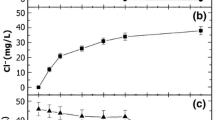Abstract
Degradation mechanism of p-cresol in aqueous solutions by gamma-ray irradiation was investigated at various initial p-cresol concentrations with different absorbed doses. The results show that p-cresol in aqueous solutions can effectively be degraded by gamma-ray irradiation. Chemical oxygen demand was used to assess the degree of mineralization of p-cresol. The degradation can be enhanced by the additions of free Radical Scavengers. The degradation products were identified by high-performance liquid chromatography with tandem mass spectrometric. Degradation mechanism of p-cresol in aqueous solutions were proposed according to the products analysis.





Similar content being viewed by others
References
Rajkumar D, Palanivelu K (2003) Electrochemical degradation of cresols for wastewater treatment. Ind Eng Chem Res 42(9):141–151
Giabbai F, Cross W, Chian E et al (1985) Characterization of major and minor organic pollutants in wastewaters from coal gasification processes. Int J Environ Anal Chem 20(1):113–129
Brasquet C, Subrenat E, Cloirec PL (1999) Removal of phenolic compounds from aqueous solution by activated carbon cloths. Water Sci Technol 39:201–205
Preis S, Terentyeva Y, Rozkov A (1997) Photocatalytic oxidation of phenolic compounds in wastewater from oil shale treatment. Water Sci Technol 35(4):165–174
Kavitha V, Palanivelu K (2004) The role of ferrous ion in Fenton and photo-Fenton processes for the degradation of phenol. Chemosphere 55(9):1235–1243
Christoskova S, Stoyanova M (2001) Degradation of phenolic waste waters over Ni-Oxide. Water Res 35(8):2073–2077
Stü F, Font J, Eftaxias A et al (2005) Chemical wet oxidation for the abatement of refractory non-biodegradable organic wastewater pollutants. Process Saf Environ Prot 83(4):371–380
Sung RH, Soydoa V, Hiroaki O (2000) Biodegradation by mixed microorganism of granular activated carbon loaded with a mixture of phenols. Biotechnol Lett 22:1093–1096
Bae HS, Lee JM, Lee ST (1996) Biodegradation of 4-chlorophenol via a hydroquinone pathway by arthrobacter ureafaciens CPR706. FEMS Microbiol Lett 145(1):125–129
Pérez RR, Benito GG, Miranda MP (1997) Chlorophenol degradation by Phanerochaete chrysosporium. Biores Technol 60(3):207–213
Annadurai G, Juang RS, Lee DJ (2002) Microbiological degradation of phenol using mixed liquors of Pseudomonas putida and activated sludge. Waste Manag 22(7):703–710
Senthilvelan T, Kanagaraj J, Rames C (2014) Biodegradation of phenol by mixed microbial culture: an eco-friendly approach for the pollution reduction. Clean Technol Environ Policy 16:113–126
Pakshirajan K, Dipankar C, Saravanan P (2008) Feasibility of m-cresol degradation using an indigenous mixed microbial culture with glucose as co-substrate. Clean Technol Environ Policy 10:303–308
Peng Y, He S, Wang J et al (2012) Comparison of different chlorophenols degradation in aqueous solutions by gamma irradiation under reducing conditions. Radiat Phys Chem 81(10):1629–1633
Shaoqing Y, Jun H, Jianlong W (2010) Radiation-induced catalytic degradation of p-nitrophenol (PNP) in the presence of TiO2 nanoparticles. Radiat Phys Chem 79(10):1039–1046
Wojnárovits L, Takács E (2008) Irradiation treatment of azo dye containing wastewater: an overview. Radiat Phys Chem 77(3):225–244
Ewicz P, Czaplicka M, Szewczynska M (2002) Radiolytic degradation and toxicity changes in gamma-irradiated solutions of 2, 4-dichlorophenol. Radiat Phys Chem 65(02):357–366
Yu S, Hu J, Wang J (2010) amma radiation-induced degradation of p-nitrophenol (PNP) in the presence of hydrogen peroxide (H2O2) in aqueous solution. J Hazard Mater 177(1–3):1061–1067
Hu J, Wang J (2007) Degradation of chlorophenols in aqueous solution by γ-radiation. Radiat Phys Chem 76(8):1489–1492
Roder M, Wojnárovits L, Földiák G (1999) Addition and elimination kinetics in OH radical induced oxidation of phenol and cresols in acidic and alkaline solutions. Radiat Phys Chem 54(5):475–479
Wojnárovits L, Földiák G, D’Angelantonio M et al (2002) Mechanism of OH radical-induced oxidation of p-cresol to p-methylphenoxyl radical. Res Chem Intermed 28(4):373–386
Wojnárovits L, Takács E (2014) Rate coefficients of hydroxyl radical reactions with pesticide molecules and related compounds: a review. Radiat Phys Chem 96(2):120–134
Zheng ZH, Cui JL, Shao HW (2007) Determination of m-cresol content in waste water by differential spectrophotometry. Appl Chem Ind 36(11):1141–1142
Spotheim-Maurizot M, Mostafavi M, Douki T et al (2008) Radiation chemistry: from basics to applications in material and life sciences. EDP Sciences, Les Ulis
Qiburi B, Lujun C, Jinping T et al (2014) Degradation of 2-mercaptobenzothiazole in aqueous solution by gamma irradiation. Radiat Phys Chem 103:198–202
Buxton GV, Greenstock CL, Helman WP et al (1998) Critical Review of rate constants for reactions of hydrated electrons, hydrogen atoms and hydroxyl radicals (·OH/·O– in Aqueous Solution. J Phys Chem Ref Data 17(2):513–886
Spinks JWT, Woods RJ (1990) An introduction to radiation chemistry, 3rd edn. Wiley, New York
Acknowledgements
This work was supported by the Fundamental Research Funds for the Central Universities (Grant No. NS2017037). And this work was supported by a Project Funded by the Priority Academic Program Development of Jiangsu Higher Education Institutions (PAPD).
Author information
Authors and Affiliations
Corresponding author
Rights and permissions
About this article
Cite this article
Ling, Y., Fei, X., Shan, Q. et al. Degradation mechanism of p-cresol in aqueous solutions by gamma-ray irradiation. J Radioanal Nucl Chem 316, 993–999 (2018). https://doi.org/10.1007/s10967-018-5883-4
Received:
Published:
Issue Date:
DOI: https://doi.org/10.1007/s10967-018-5883-4




